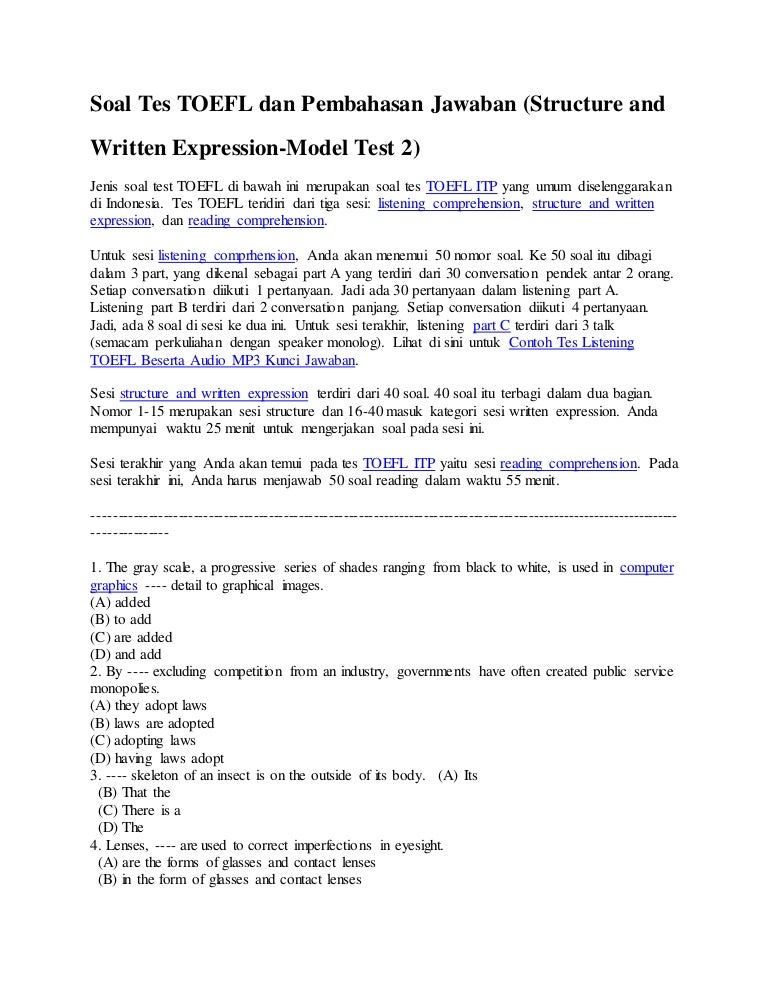

/ / Free Online TOEFL - Reading Comprehension Test 1 'The evolution of the banana, star of the Western fruit bowl' By Rosie Mestel Did you hear? The genome of the banana has been sequenced, an important development in scientist's efforts to produce better bananas.
'Barsuchii shtat' (shutl. Bagdad baggy 1> meshkovatyi; dryablyi, obvisshii _Ex: baggy cheeks dryablye sheki _Ex: baggy trousers (ponoshennye ili neotglazhennye) bryuki s puzyryami na kolenkah _Ex: baggy skin under one's eyes meshki pod glazami 2> vysokoparnyi, napyshennyi (o rechi) bagheera 1> nemnushiisya barhat, panbarhat bahadur 1> _ind. Nazvanie shtata Viskonsin) baedeker 1> Bedeker (nazvanie putevoditelei po raznym stranam dlya puteshestvennikov, turistov) _Ex: a baedeker to the restaurants of Europe spravochnik restoranov Evropy baffin bay noun Baffinov zaliv bag(h)dad noun g. Programma dlya rascheta shesteren.
Sample questions for Section 2 – Structure and Written Expression of the TOEFL ITP Level 1 test. Normalized URL: Submission date: Sat May 5 08. Server IP address: 5.144.133.146. Country: Iran, Islamic.
A look at that genome has revealed curious things, said Pat Heslop-Harrison, a plant geneticist at the University of Leicester in England who was a coauthor of the report published this week in the journal Nature. For example, there are regions of the banana genome that don't seem to be involved in making proteins but are shared by many different species of plants, far beyond bananas. What, he wonders, are they doing?
There are remnants of bits of banana streak virus spliced into the banana genome (too broken-up to cause disease, however). There are whole sets of DNA repeats that plants normally have but bananas do not. And, intriguingly, three times since this genus of giant herbs took an evolutionary turn away from its relatives -- the grasses -- it has duplicated its entire set of chromosomes. Two of the doublings took place at the Cretaceous-Tertiary boundary 65 million years ago, back when the dinosaurs and lots of other species went extinct, Heslop-Harrison noted. Duplications like this are known to have happened in other plant groups at this same time but haven't occurred since, Heslop-Harrison said. Scientists don't know why, but they believe having extra copies of genes may have imparted some stability to plants during a time of rapid climate change after an asteroid hit Earth. Having more than one gene of each type means that if one gene of a set loses function, the plant still has another one that works.
And there's more room for adaptability to new circumstances, because one gene could be altered and co-opted for new purposes and there would still be the other one left to perform the original job. 'Perhaps it's the reason [bananas have] done so well in the subsequent millions of years,' Heslop-Harrison said. 'One can ask, will changes occurring in the world's climate now mean there's going to be a whole set of new genome duplications that will enable plants to survive? We don't know that, but it's interesting to consider.' The banana genome sequenced by the French scientists was from the Pahang, a wild Malaysian banana of the species Musa acuminata. It's a key species in the complicated evolution of the bananas and plantains people eat around the world, including the Cavendish banana that we buy at the supermarket.
The sterile Cavendish is a so-called triploid: It has three sets of chromosomes instead of the normal two. One of those genomes came from Pahang. The others came from other subspecies of Musa acuminata. The changes occurred stepwise, and went something like this: • Thousands of years ago, two wild banana species from different parts of the islands of Southeast Asia were brought into the same range by people. They formed hybrids. A bit like mules, the hybrids were vigorous but fairly sterile. • The hybrids were kept going without sex through propagation of their shoots.
Scoot.net: stolen scooter registry This page contains information on stolen scooters. You may here. Instrukciya po ohrane truda predsedatelya tszh. If you have had a scooter stolen, please post any information you have in order to alert shops and other scooterists of the theft. Entries made on the page will remain posted indefinitely.
• At some point, the hybrids developed the ability to set fruit without being fertilized. • Then (for most bananas, including the Cavendish) came another chance event that caused the hybrids to end up with three sets of chromosomes. Every now and again, the few viable eggs and pollen that they made would mistakenly contain two sets of chromosomes instead of just one. When a double-chromosome pollen combined with a single-chromosome egg (or vice versa), the result was a hopelessly sterile plant with even more vigorous fruit.
Events like this happened more than once and sometimes included other types of ancestral banana species. Some scientists, in fact, have made a whole study of banana domestication and movement around the world. They've pieced the story together using quite different strands of information, including the genomes of wild and cultivated bananas, the microscopic relics of banana leaf material found at archaeological sites, and even the word for 'banana' in different languages. In paragraph 2, the word 'curious' is closest in meaning to A) inquisitive B) peculiar C) nosy D) intricate 2. What does paragraph 5 suggest about bananas?